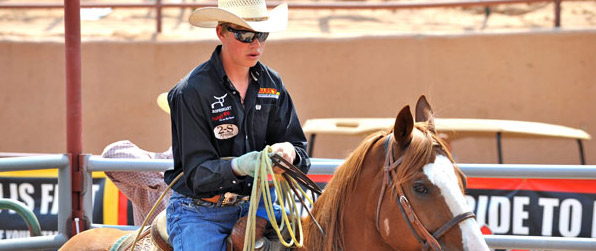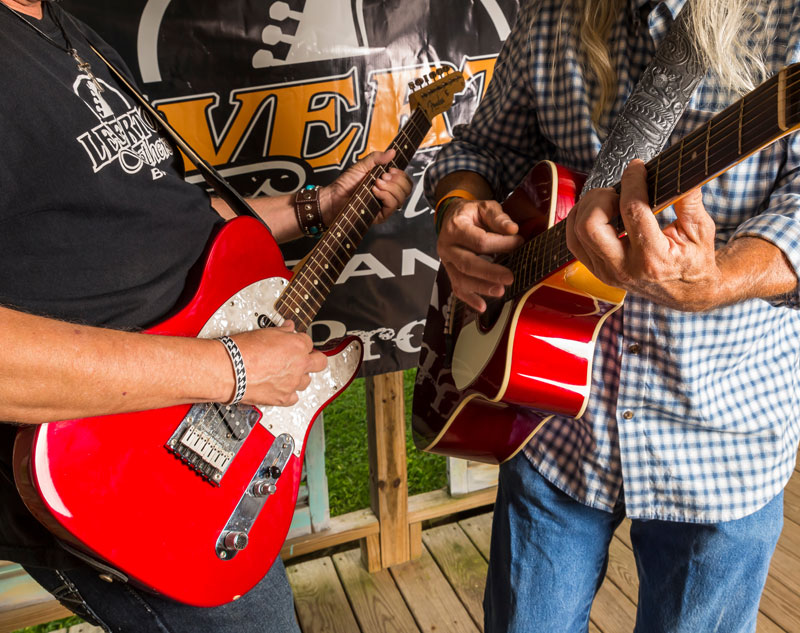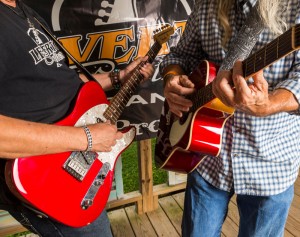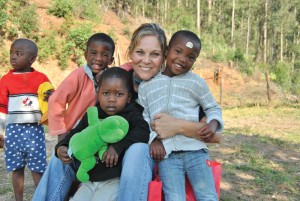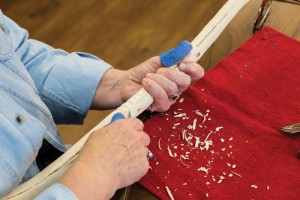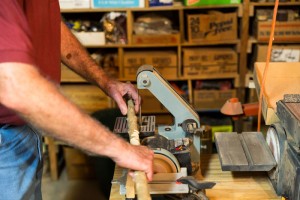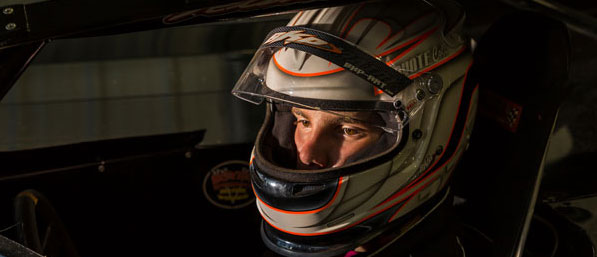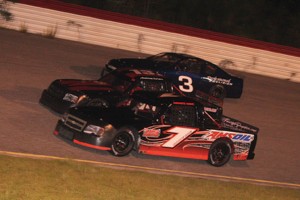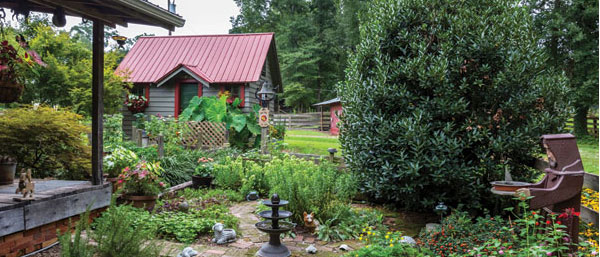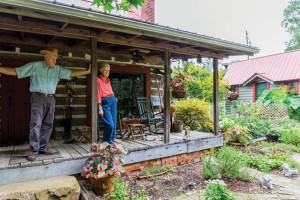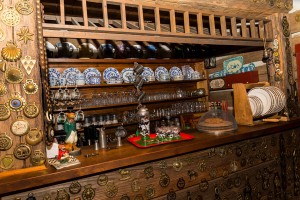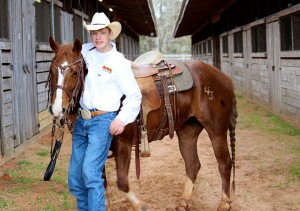 Story by Graham Hadley
Story by Graham Hadley
Photos by Graham Hadley
and Dr. Shawn Stubbs
For one St. Clair teen, the rodeo is worth giving up football and baseball for.
It’s worth giving up weekends, afternoons and most free time in between.
In fact, John-Cody Dale Stubbs’ Xbox has been broken for several years now … and he doesn’t miss it a bit.
Instead, the 15-year-old freshman at Briarwood Christian has a whole host of things he would rather be doing — bull riding, chute dogging (steer wrestling), goat tying and, his absolute favorite, team calf roping, among other rodeo events.
Cody looks like a natural on the back of his horse as he practices in the ring his father built on their property by their house in St. Clair County, and that innate talent and hard work are already paying off. He has been bringing in awards at competitions at both the state and national levels in calf roping and other events and sees no end in sight.
Row after row of winning buckles lined the dining-room table in front of Cody as he pointed to his favorite — a sportsmanship award — one of the few buckles he does not wear to keep it pristine.
His father, Dale, who is a retired firefighter and contractor, is quick to clarify that the sportsmanship award is not a “participation” award, but one of the top recognitions that is carefully considered by the judges.
“When he first won it, I thought it was a consolation prize, but they told me it was a big deal — that the vote for Cody had been unanimous,” he said.
Dale said he was not surprised that Cody had won it, but the behavior necessary to acquire the much-prized award is a common thread in the rodeo community.
“That’s the way rodeo kids are. They are really good kids who have spent a lot of time with their family and are well raised,” he said.
Cody has also won several saddles and some money from his competitions. Though he is very competitive and doing well now, he hopes to one day get a bigger piece of the winnings, which he says can run into the hundreds of thousands of dollars.
Dedication to the sport
Dale was not exaggerating when he said rodeo kids spend a lot of time with their families. In addition to normal family time, they spend most weekends and parts of the week traveling to various competitions, some just down the road, some in places like New Mexico and Oklahoma.
In fact, Cody and his Dad were gearing up to leave for another trip the day after his interview for Discover — they had been in Oklahoma the weekend before.
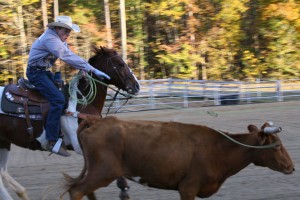 And where many traveling competitive athletes can fly to their destinations, Cody usually rides his own horses at each event, so those trips, both near and far, are on the road with the horses and all their support gear along for the ride.
And where many traveling competitive athletes can fly to their destinations, Cody usually rides his own horses at each event, so those trips, both near and far, are on the road with the horses and all their support gear along for the ride.
In addition to competition road trips, Cody’s school is almost an hour from where he practices. A normal weekday afternoon sees Dale picking up Cody from Briarwood, driving to get something to eat, then he practices roping until around 9 p.m. every day. When he gets home, he has to take care of his horses and gear and many days, help get the RV packed and ready to hit the road to another show.
If he has any free time from all of that, Cody also has to train a new colt for riding.
“He ropes almost all weekends, so it is a six-day-a-week job,” said his mother, Dr. Shawn Stubbs.
And though he has missed some school for competitions, Cody also has his sights set on being a veterinarian one day, so his education is very important, too. He gets his homework done sitting in the truck on the way to practice. They plan on returning from an upcoming trip early in the morning and heading straight from the airport to get the aspiring animal doctor to school on time.
“You have to love it to do it,” Cody said.
From bull-riding to team roping
For all his dedication and the growing stack of awards — 18 buckles and several saddles — Cody has only been competing for a relatively short time.
“I have been doing this two and a half to three years,” he said. “I grew up around horses and animals. One day we went to Tractor Supply in Moody. There was a flier for a youth rodeo. I wanted to try bull riding. I also signed up for chute dogging.”
The first event was a win for Cody, just not the way he expected.
“I did pretty good at steer wrestling, but got bucked off bull riding.
“That was at Dusty Bottoms Rodeo in Sterrett. I noticed they gave away saddles for the most points. I realized I would have to do roping and horse events to win and started training in roping,” he said.
His mother was in the process of purchasing a horse from Wil and Rodney Sanders in Ardmore, and Dale said he was impressed by their operation.
“They were so nice. We asked about roping lessons for Cody.”
Then Cody “stole” his mother’s new horse to use for roping and riding, Dale joked.
Cody was working hard and competing and doing well, but he was not winning the events like he wanted to, so the Stubbs turned to Kenny Ellison from Calera.
“He has been helping me lately with my roping and riding,” Cody said.
Dale said he cold-called Ellison. “He is a very good guy. He took Cody in. Cody was roping really well but not winning. I called Kenny out of the blue. He did not know us.”
He has made a big difference for Cody in the arena.
“That’s just the way people in this sport are. The will help a kid out,” Dale said.
Gaining ground
Cody has been doing so well at a variety of events that he is starting to find sponsors — one of which is flying him out to Las Vegas and paying all his expenses there so he can do some product promotion and exhibition riding and roping.
RopeSmart has not only given Cody some much-needed equipment like practice steers and special wraps for the saddle horn, Cody got to rope with the owner at the national finals.
Standard Process does not do direct sponsorships for Cody, but they do help by providing some of the feed and other supplies for the horses.
Locally, he gets a lot of support from Jodie’s Harness & Tack. Dale said he could not say enough about the help and advice they get from the local business, located in the famous stacked-rock building on the outskirts of Odenville.
But the winning and everything that goes with it did not happen all at once. Many of the events Cody attends just focus on team calf roping, where he is usually the header, or steer wrestling. There are many levels and many different events to master for rodeo competition.
It was a lot to learn.
In team calf roping, as header “I catch the head of the steer (with a rope from horseback) and turn it for my heeler, who catches the back two feet,” Cody said.
“I also heel, where I catch the back two feet and get a dally and stretch the steer out.”
Aside from just liking roping, Cody said it is also his favorite sport because you can do it all your life — he sees ropers in their 80s at some events.
Other rodeo events — particularly bull riding — are more physical and more dangerous.
For bull riding “you draw your bull. They load him into a bucking chute. You have a bull rope. I wear a helmet, vest, chaps, a special leather glove to hold the rope and big spurs to get a better grip with,” he said.
The goal is to stay on for eight seconds
“I have gotten a lot better. I cover the ride — eight seconds — most of the time now,” he said.
Chute dogging — also called steer wrestling — is another sport Cody excels at but also takes its physical toll. Cody once had a gate not open right and ended up with a knee injury that day.
“Rodeo officials load the steer into a bucking chute. I get in there with it, get my arm around the steer’s neck and give a nod — the gate opens. You can’t touch the steer’s horns until you cross a line 8 feet from the chute. Then you grab the horns and use a certain technique to get the steer on the ground as fast as you can,” Cody said.
That event is the one that drew Cody to the state championship and is part of a national organization.
“That is what I went to New Mexico for,” Cody said.
His broad talent has opened many doors for him competitively. And once he started winning, Cody turned all his attention to roping and other rodeo events.
“He used to play baseball and football. He gave them up for this. He said, ‘Dad, I want to rope,’” Dale said.
For Cody, he sees two things in his future — “I would really like to get better. Go professional after (his parents emphatically agreed with this), after I graduate from vet school.”











